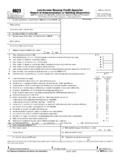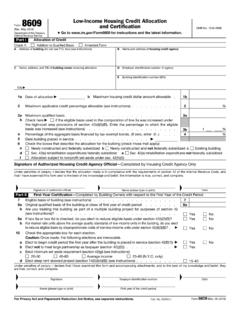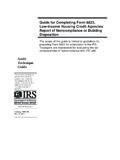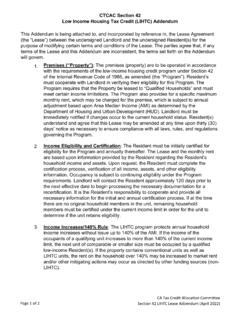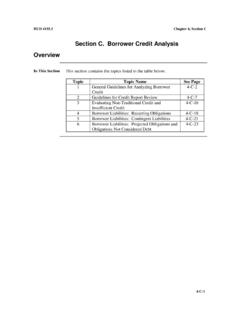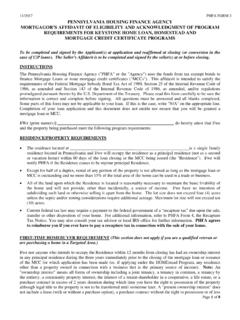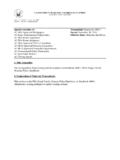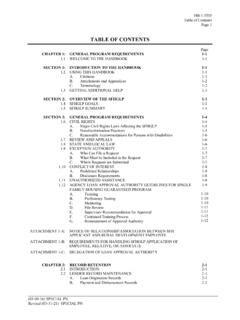Transcription of Part I Section 42.--Low-Income Housing Credit (Also §§ 1 ...
1 Part I Section Housing Credit (Also , , ) Rev. Rul. 2004-82 PURPOSE This revenue ruling answers certain questions about the low-income Housing Credit under ' 42 of the Internal Revenue Code. LAW AND QUESTIONS AND ANSWERS A. ELIGIBLE BASIS AND QUALIFIED BASIS ISSUES Law Section 42(a) provides for a Credit for investment in certain low-income Housing buildings. The amount of the low-income Housing Credit for any taxable year in the Credit period is an amount equal to the applicable percentage of the qualified basis of each qualified low-income building (as defined in 42(c)(2)). Section 42(c)(1)(A) provides that the qualified basis of any qualified low-income building for any taxable year is an amount equal to (i) the applicable fraction (determined as of the close of the taxable year) of (ii) the eligible basis of the building (determined under ' 42(d)). Section 42(c)(1)(B) defines the applicable fraction as the smaller of the unit fraction or the floor space fraction.
2 Section 42(c)(1)(C) defines the unit fraction as the fraction the numerator of which is the number of low-income units (as defined in 42(i)(3)(A)) in the building and the denominator of which is the number of residential rental units (that is, all units in the building which are available to rent as personal residences), whether or not occupied, in the building. Section 42(c)(1)(D) defines the floor space fraction as the fraction the numerator of which is the total floor space of the low-income units in the building and the denominator of which is the total floor space of the residential rental units, whether or not occupied, in the building. Section 42(d)(1) provides that the eligible basis of a new building is its adjusted basis as of the close of the first taxable year of the Credit period. Section 42(d)(4)(A) provides that, except as provided in ' 42(d)(4)(B) and (C), the adjusted basis of any building is determined without regard to the adjusted basis of any property that is not residential rental property.
3 Section 42(d)(4)(B) provides that the adjusted basis of any building includes the adjusted basis of property of a character subject to the allowance - 2 -for depreciation (1) used in common areas or (2) provided as comparable amenities to all residential rental units in the building. Section 42(d)(4)(C)(i) provides that the adjusted basis of any building located in a qualified census tract is determined by taking into account the adjusted basis of property (of a character subject to the allowance for depreciation and not otherwise taken into account) used throughout the taxable year in providing any community service facility. Section 42(d)(4)(C)(iii) provides that the term Acommunity service facility@ means any facility designed to serve primarily individuals whose income is 60 percent or less of area median income (AMGI) (within the meaning of ' 42(g)(1)(B)). Section 42(d)(5)(C)(ii)(I) defines the term Aqualified census tract@ as any census tract (1) which is designated by the Secretary of Housing and Urban Development (HUD), and (2) for the most recent year for which census data are available on household income in the tract, either in which 50 percent or more of the households have an income which is less than 60 percent of the AMGI for the year or which has a poverty rate of at least 25 percent.
4 See for a listing of census tracts designated by the Secretary of HUD. Section 42(d)(4)(C)(ii) provides that the increase in the adjusted basis of any building which is taken into account because of a community service facility may not exceed 10 percent of the eligible basis of the qualified low-income Housing project (as defined in 42(g)(1)) of which the community service facility is a part. For this purpose, ' 42(d)(4)(C)(ii) provides that all community service facilities which are part of the same qualified low-income Housing project are treated as one facility. Rev. Rul. 2003-77, 2003-29 75, provides that the requirement that a community service facility must be designed to serve primarily individuals whose income is 60 percent or less of AMGI will be satisfied if the following conditions are met. First, the facility must be used to provide services that will improve the quality of life for community residents. Second, the taxpayer must demonstrate that the services provided at the facility will be appropriate and helpful to individuals in the area of the project whose income is 60 percent or less of AMGI.
5 This may, for example, be demonstrated in the market study required to be conducted under ' 42(m)(1)(A)(iii), or another similar study. Third, the facility must be located on the same tract of land as one of the buildings that is part of the qualified low-income Housing project. Finally, if fees are charged for services provided, they must be affordable to individuals whose income is 60 percent or less of AMGI. The legislative history of ' 42 states that residential rental property for purposes of the low-income Housing Credit has the same meaning as residential rental property for purposes of ' 103. The legislative history of ' 42 further states that residential rental property includes residential rental units, facilities for use by the tenants, and other facilities reasonably required by the project. Conf. Rep. No. 841, 99th Cong., 2d Sess. II-89 (1986), 1986-3 (Vol. 4) 89. - 3 - In the Tax Reform Act of 1986 (the "1986 Act"), Congress reorganized 103 and 103A of the Internal Revenue Code of 1954 (the "1954 Code") regarding tax-exempt bonds into 103 and 141 through 150 of the Internal Revenue Code of 1986.
6 Congress intended that to the extent not amended by the 1986 Act, all principles of pre-1986 Act law would continue to apply to the reorganized provisions. Conf. Rep. No. 841, 99th Cong., 2d Sess. II-686 (1986), 1986-3 (Vol. 4) 686. Because no regulations have been promulgated relating to residential rental property for purposes of 103, the regulations relating to residential rental property promulgated pursuant to the 1954 Code continue to apply except as otherwise modified by the 1986 Act and subsequent law. Under ' (b)(4)(i) of the Income Tax Regulations, facilities that are functionally related and subordinate to residential rental projects are considered residential rental property. Section (b)(4)(iii) provides that functionally related and subordinate facilities include facilities for use by the tenants, such as swimming pools and other recreational facilities, parking areas, and other facilities reasonably required for the project.
7 Examples in ' (b)(4)(iii) of facilities reasonably required for a project include units for resident managers or maintenance personnel. Q-1. A new qualified low-income building (Building) is located in an area in which owners of apartment buildings typically employ security officers due to the level of crime in the area. (a) If a unit in Building is occupied by a full-time security officer for that building and Building s owner requires the security officer to live in the unit, is the adjusted basis of that unit includable in Building=s eligible basis under ' 42(d)(1)? (b) If yes, is that unit a residential rental unit includable in the numerator and denominator of Building=s applicable fraction under ' 42(c)(1)(B)? A-1. (a) Yes. The legislative history of 42 indicates that residential rental property includes, in addition to the residential rental units, facilities for use by the tenants and other facilities reasonably required by the project.
8 Under (b)(4)(iii), functionally related and subordinate property is property that is reasonably required for the project. Examples of functionally related and subordinate property are units for resident managers or maintenance personnel. See (b)(4)(iii). Thus, while units for resident managers or maintenance personnel are not residential rental units, they are treated as part of residential rental property because these units are functionally related and subordinate to the project. The unit occupied by a full-time security officer is similar to the units described in the - 4 -examples contained in (b)(4)(iii), and is reasonably required by the project because of the level of crime in the area. Thus, the unit is functionally related and subordinate to Building. As a result, the unit is residential rental property for purposes of 42 and its adjusted basis is includable in Building s eligible basis under 42(d)(1). (b) No.
9 The term Aresidential rental unit@ has a different meaning than the term residential rental property for purposes of 42. Under ' (b)(4)(iii), units for resident managers or maintenance personnel are residential rental property because they are functionally related and subordinate to residential rental projects, not because they are residential rental units. Similarly, a unit occupied by a full-time security officer is not a residential rental unit. Only residential rental units are includable in Building=s applicable fraction under ' 42(c)(1)(B). If in a later year of the Credit period, the unit occupied by the full-time security officer is converted to a residential rental unit, the unit will be includable in the denominator of Building=s applicable fraction for that year. If the unit also becomes a low-income unit in a later year, the unit will be includable in the numerator of Building=s applicable fraction for that year. Q-2.
10 A new qualified low-income building (Building) received a Housing Credit allocation on June 1, 2003, and was placed in service in 2004. Building is located in a qualified census tract (as defined in 42(d)(5)(C)). The neighborhood in which Building is located is an area with a high rate of crime. In 2004, the local police department leases a unit in Building to be used as a police substation (Facility). The Facility is part of the police department s community outreach program. This Facility is intended to serve as a deterrent to crime in the community, assist the community with solving crime-related problems, reduce the response time to area calls for service, and provide the locally assigned police officers with a local office. The services provided by the police are free of charge. The adjusted basis of the property constituting the Facility (of a character subject to the allowance for depreciation and not otherwise taken into account in the adjusted basis of Building) does not exceed 10 percent of the eligible basis of Building.










